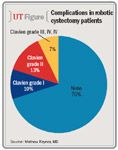Article
Robotic cystectomy safe, efficacious in experienced hands
Robot-assisted radical cystectomy can be performed safely and effectively by urologists who are experienced with robotic surgery.
Washington-Robot-assisted radical cystectomy can be performed safely and effectively by urologists who are experienced with robotic surgery, according to results of a multicenter review.

First author Mathew Raynor, MD, and co-authors reviewed 227 patients (178 male, 49 female) who underwent robotic cystectomy and urinary diversion at the University of North Carolina, Chapel Hill, Mayo Clinic, Scottsdale, AZ, Tulane University, New Orleans, or the University of Alabama, Birmingham. They focused on complication rates and how those compared with previously compiled rates in open cystectomy.

Perioperative complications were recorded and classified using the Clavien system. The overall complication rate was 30%, with 7% of patients experiencing a Clavien grade III or higher complication, which is comparable to previous open cystectomy cohort reports.
Multivariate analysis showed that age was a significant predictor of more serious complications (p=.0204). Patients >60 years of age were twice as likely to have a higher Clavien complication rate when controlling for other variables.
BMI yielded a similar result. Patients with BMIs >25 were 1.8 times more likely than those with BMIs ≤25 to experience a higher Clavien complication rate. Higher ASA scores also led to a higher incidence of complications. Additionally, length of hospital stay was longer for patients with complications (4.9 vs. 6.8 days, p<.05).
"We hypothesized that age, BMI, and ASA would factor into overall complications, as previous surgical series have demonstrated these factors to be predictive of complications," Dr. Raynor said. "Since that was indeed the case, these patients likely should not be approached robotically until the urologist gains more experience with the procedure and feels comfortable tackling more challenging cases."
Newsletter
Stay current with the latest urology news and practice-changing insights — sign up now for the essential updates every urologist needs.















